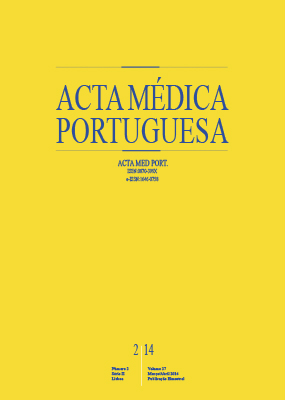Acute Respiratory Distress Syndrome: Case Series, Two Years at an Intensive Care Unit
DOI:
https://doi.org/10.20344/amp.4266Abstract
Introduction: Acute Respiratory Distress Syndrome has a significant incidence and mortality at Intensive Care Units. Therefore, more studies are necessary in order to develop new effective therapeutic strategies. The authors have proposed themselves to characterize Acute Respiratory Distress Syndrome patients admitted to an Intensive Care Unit for 2 years.Material and Methods: This was an observational retrospective study of the patients filling the Acute Respiratory Distress Syndrome criteria from the American-European Consensus Conference on ARDS, being excluded those non invasively ventilated. Demographic data, Acute Respiratory Distress Syndrome etiology, comorbidities, Gravity Indices, PaO2/FiO2, ventilator modalities and programmation, pulmonary compliance, days of invasive mechanical ventilation, corticosteroids use, rescue therapies, complications, days at
Intensive Care Unit and obits were searched for and were submitted to statistic description and analysis.
Results: A 40 patients sample was obtained, with a median age of 72.5 years (interquartile range = 22) and a female:male ratio of ≈1:1.86. Fifty five percent of the Acute Respiratory Distress Syndrome cases had pulmonary etiology. The mean minimal PaO2/FiO2 was 88mmHg (CI 95%: 78.5–97.6). The mean maximal applied PEEP was 12.4 cmH2O (Standard Deviation 4.12) and the mean maximal used tidal volume was 8.2 mL/ Kg ideal body weight (CI 95%: 7.7–8.6). The median invasive mechanical ventilation days was 10. Forty seven and one half percent of the patients had been administered corticosteroids and 52.5% had been submitted to recruitment maneuvers. The most frequent complication was Ventilator Associated Pneumonia (20%). The median Intensive Care Unit stay was 10.7 days (interquartile range 10.85). The fatality rate was 60%. The probability of the favorable outcome ‘non-death in Intensive Care Unit’ was 4.4x superior for patients who were administered corticosteroids and 11x superior for patients < 65 years old.
Discussion and Conclusions: Acute Respiratory Distress Syndrome is associated with long hospitalization and significant mortality. New prospective studies will be necessary to endorse the potential benefit of steroid therapy and to identify the subgroups of patients that warrant its use.
Downloads
Downloads
Published
How to Cite
Issue
Section
License
All the articles published in the AMP are open access and comply with the requirements of funding agencies or academic institutions. The AMP is governed by the terms of the Creative Commons ‘Attribution – Non-Commercial Use - (CC-BY-NC)’ license, regarding the use by third parties.
It is the author’s responsibility to obtain approval for the reproduction of figures, tables, etc. from other publications.
Upon acceptance of an article for publication, the authors will be asked to complete the ICMJE “Copyright Liability and Copyright Sharing Statement “(http://www.actamedicaportuguesa.com/info/AMP-NormasPublicacao.pdf) and the “Declaration of Potential Conflicts of Interest” (http:// www.icmje.org/conflicts-of-interest). An e-mail will be sent to the corresponding author to acknowledge receipt of the manuscript.
After publication, the authors are authorised to make their articles available in repositories of their institutions of origin, as long as they always mention where they were published and according to the Creative Commons license.









